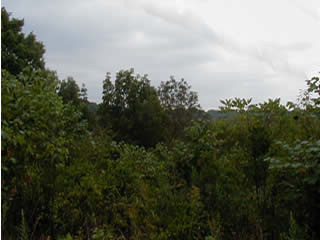|

Forests
A temperate deciduous forest is characterized
by a collection of broad- leaved trees such as hickory, maple,
oak, poplar, and sycamore; the scrubs and bushes that make
up an understory canopy layer; and finally, an herbaceous
moss ground layer. Rainfall must be adequate (thirty to sixty
inches annually) and evenly dispersed throughout the year.
These forests grow in areas where the climate is fairly moderate
with significant seasonal climate changes which include long
and warm summers, and cold, but not too severe, winters. The
trees in these forests survive the winters by shedding their
leaves in the fall and becoming dormant until spring.
Today, Indiana's forests, often referred to as
"woods," are a "small fragment left from a
vast green expanse, rich, varied, and ecologically resilient”
(Petty 110). Most of the forests in Indiana are categorized
as secondary growth forests—that is, they were at one
point cleared by human beings and now have gone through, or
are going through, the process of regrowth. This process is
not a quick or an easy one. First, a layer of early weeds,
forbs, and grasses gives way to larger brush such as briars
and goldenrods. Then a collection of young saplings begins
to take form. Anywhere from ten to fifty years later, small
trees, shrubs, and flowering herbs begin to flourish.
This process has not replicated, and may never
replicate, the size or magnitude of the trees of Indiana’s
almost extinct old growth forests, which is the term for "forests
that have suffered little or no logging or livestock grazing,
and appear largely as they did prior to European colonization."
Old growth forests are known for their "deep, multilayered
canopies, abundance of shade-tolerant understory plants, [and]
plentiful snags and downed trunks" (McManus 48).
Often, but not always, old-growth forests are
noted for the size of the trees. For example, the tulip tree,
which is the state tree, on average reached a diameter of
eleven feet and a height of 110 to 168 feet in the late 1700
and early 1800s. Today, the largest tulip trees in the state
are a pair of secondary growth trees in Hemmer Woods, Gibson
County, that measure only five feet in diameter and just over
150 feet in height.
Prior to settlement, it is believed that Indiana
was home to approximately 2.2 billion trees—or about
400 trees per current Hoosier resident. In fact, "accounts
from Native Americans, settlers, and the Government Land Office
show that Indiana was over eighty-five percent forestland
as recently as 200 years ago" (United States 4). Sadly,
this is hardly the case today. For example, in southern
Indiana, which has the most continuous forests in the state,
road construction to meet the increased demand for access
to the smaller forests has been a topic of much discussion.
Fortunately, in the northern part of the state, "it appears
that forestland is rebounding and new forested habitat is
being developed for wildlife" (United States 5).
See also deforestation.
Sources:
McManus, Reed. "American Roots."
Sierra Nov.-Dec. 2002: 48-57.
Petty, Robert O. "Origins: The
Deciduous Forest." The Natural Heritage of Indiana.
Ed. Marion T. Jackson. Bloomington: Indiana UP, 1997. 110-12.
United States. Department of Agriculture.
Northeastern Area State and Private Forestry. "What Is
the History of Indiana's Forests?" Forests of Indiana:
A 1998 Overview. By Barbara Tormoehlen, Thomas L. Schmidt,
and Joey Gallion. Sept. 2000. 13 Nov. 2002
<www.na.fs.fed.us/spfo/pubs/misc/in98forests/what.pdf>.
|




